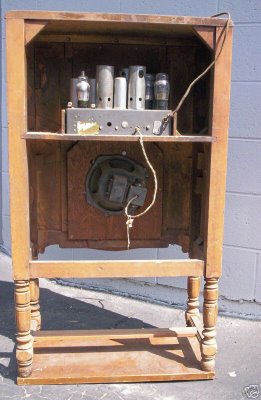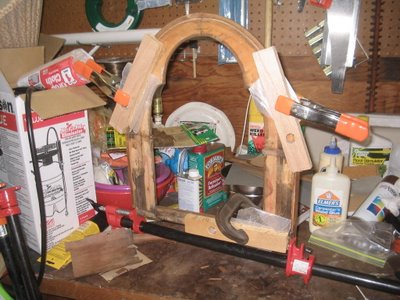Time for an update!
I've spent a lot of time recently, collecting parts for my current projects, the battery eliminator and AM transmitter. I just finished the transmitter, and last night I fired it up for the first time. Amazing! It actually worked! Huge thanks to Bob, VE1ARN, who generously sent me a tube and socket for free.
This is a really simple design, that was put together by
Syl.I modified it based on some suggestions from Mike T. The following is an "as-built" schematic. This reflects a different power supply. The Granco UHF tuner that supplied the chassis had the transformer I need. It also has a really nice bakelite case that polished up beautifully with a rag and some Brasso. This modified schematic uses a voltage doubler, to take the voltage up from the standard 180-something, to about 385, which then gets dropped back down to about 275, which is just short of the max allowed by the 6BM8 tube. Hopefully I will get better range than I would with the standard 180.

This is an interesting design. It's really simple, but not "frequency stable" by a long-shot. Everything you do changes the frequency. You can modify the coils or caps, but even putting your hand near it will pull it off-frequency. I had some fun with this effect last night. I put my radio on SSB, and tuned it to the transmitter's frequency. This produced a tone, from the beating between the transmitter's carrier and the BFO of the radio. I was using a 3' whip antenna on the transmitter. If I brought my hand near the antenna, it caused the pitch of the het to change. Waving your hand around, you could get some pretty cool effects. A lot like a
Theremin.Anyhow, the frequency of this transmitter varies based on the antenna you use. So with the whip, I was around 1200 Khz. With a hunk of wire, it was closer to 1130, but when I hooked it to a spare pair in my phone jack, it went way down to 994 Khz. One thing I forgot to do - the original schematic has a fixed 20pf mica cap at C10. I need to change that to a variable, so that I can have some frequency adjustability (apart from what I get just being near the transmitter). Once I get my antenna built, I will take a few turns of wire off the primary of the oscillator coil, so that I can tune it to a more open frequency. My son is already looking forward to being a DJ!
I finally have all of the parts I needed for the battery eliminator. My parts order got lost in the mail, and it took 6 weeks to get it replaced. But everything is here now, and when i get a chance, I will put that together. I'm going to put it inside a box with
this design. I know it's not truly authentic, since my battery eliminator will be an A/B supply, not just a "B" like this one, but I think I should be able to modify it to add connectors for the "A" supply. And it will look really cool.
So now, you've read all this stuff, and you're wondering: What about the new radio mentioned in the title? Well, the wait is over. Check this out:


This is a Philco 89 console. Aside from a ding in one of the upper columns, and the veneer on the lower middle front, it looks to be in really good shape. These are the eBay pictures. I hope to have some more once I've picked up the radio. At the moment my son has my camera with him on a backpacking trip, so it will be a little while before I can get any pictures to put up here. I promise I'll post some pictures of the transmitter too - I'm pretty proud of how it came out, both in performance and looks.
Lastly, I guess I should update the status of the Philco 70. Not much to report there, except that a couple of weeks ago I found out that someone was giving away a Ryobi scrollsaw and bandsaw. Free! Perfect for my non-existent budget! Unfortunately I was just a bit too late, and someone else got it before I did. Bummer.
I'd love to get a scrollsaw - both for the Philco 70 project, and to play around with other neat things. The problem is that I have such limited time, that I really can't justify spending the money on it right now, since it probably won't get much use. So instead, I went to Home Depot and bought a coping saw, some extra blades, and a piece of 1/4" plywood. I'm going to try to make the front panel with these. The plywood was only $3, so if I mess up, I can just start again. If I can get a reasonable facsimile of the front panel made, then I'll invest in some veneer.
It's summer now, which means no homework to help with, and more flexible bedtimes for everyone. So I hope to be able to spend a bit more time on my radios. I've already succeeded with the transmitter, so I'm hopeful that I will be able to do the same with the other projects. I certainly have learned a lot by building the transmitter.



















